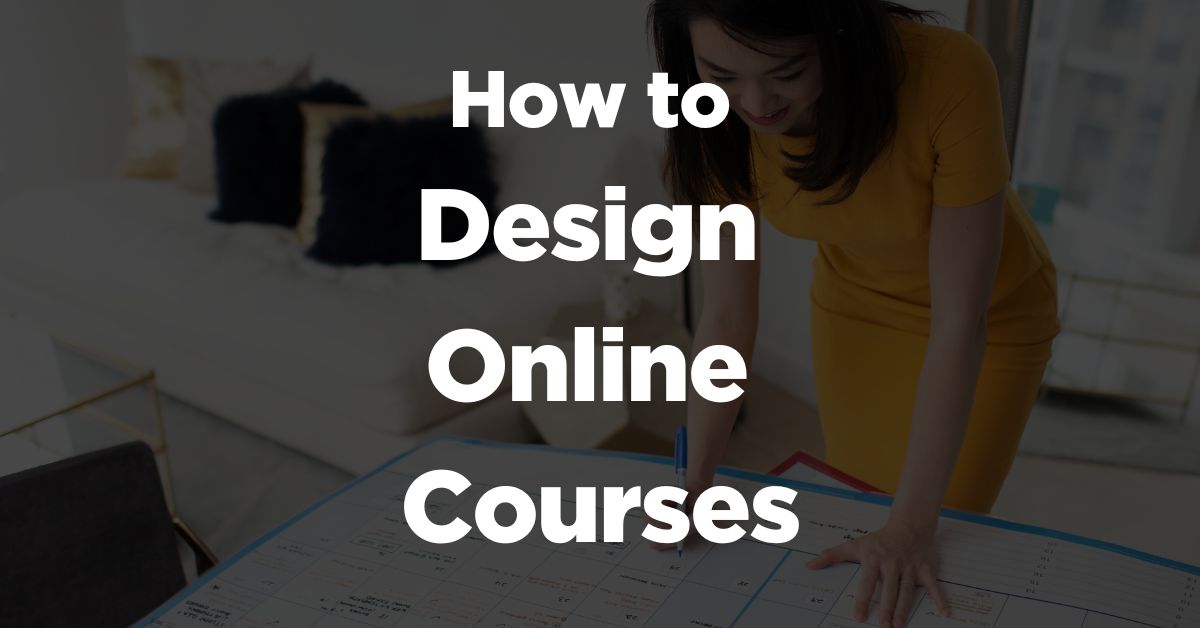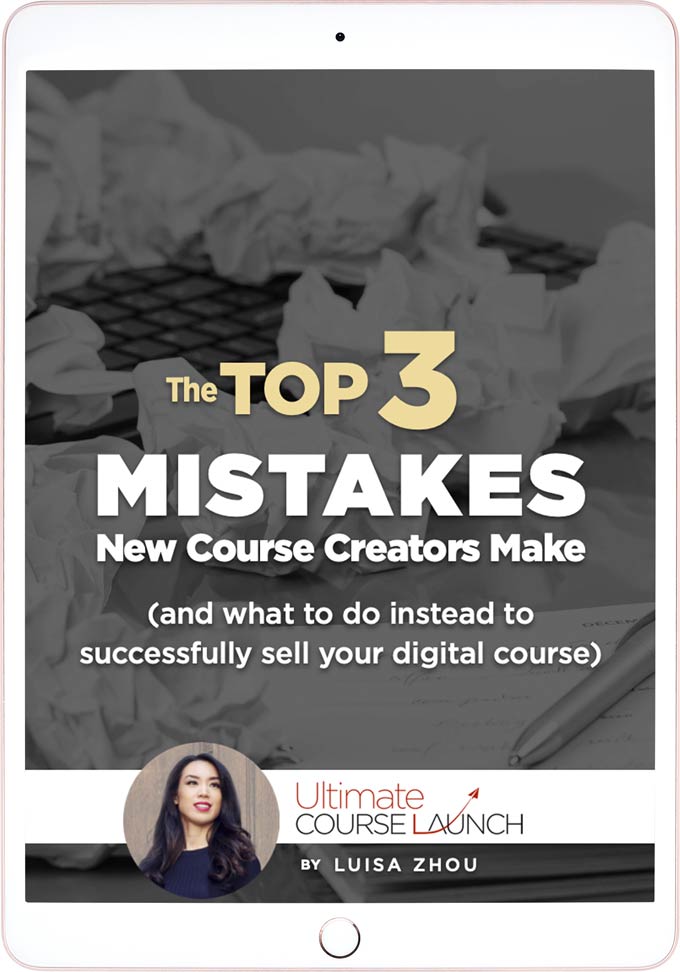Welcome to the ultimate guide to online course design!
Today, we’ll be going over all your questions and doubts about how to design an online course.
And by the end, you’ll know exactly how to create engaging online courses that keep your clients motivated and wanting more.
Let’s get started.
What is online course design?
An online course is a course that you sell “passively” to scale your business. It could be a smaller or a bigger course that teaches something to your clients.
And that’s what makes course design so important.
After all, your design makes ALL the difference for how well people learn.
Want to learn more?
Here’s how to design your course!
Online course design 101
First things first: What is online course design?
Online course design refers to creating a structured and effective online education experience for your clients.
For this, you need to understand your audience. What are their needs, desires, challenges, and obstacles?
Designing a great online course is quite straightforward. There are three main steps:
- Set learning objectives
- Structure your course
- Check effectiveness
I explain a bit more in this quick video:
We’ll cover the entire process in depth later, but for now, let’s already take a quick look at number one:
Setting clear learning objectives.
What results will your clients get at the end of the course?
After all, your course business solves a problem for your online students.
To stand out, it needs to solve that problem in a better, faster, and cheaper way.
And for this, you need to understand learning objectives (what your course participants will have learned at the end of the course).
You see, teaching online really comes down to obsessing over how your students will achieve their objectives in the best way. So that you create a highly effective online course that keeps students engaged.
But what is the difference between course design and development? Let’s find out.
Course design versus course development
So, how do you design and develop an online course?
Today, we’ll mostly be answering the first question:
How do you design an online course?
You see, course design and course development seem similar, but they’re not the same.
- Course development is about creating the actual content
- Course design is about shaping the learning journey to get the best results and user experience
You start with designing the course. Then, you develop it. (You can learn more about creating an online course here.)
And that’s what course design is.
But what are the key factors for designing an online course?
And what makes good online course design?
That’s what we’ll talk about next.
What makes good online course design?
Before diving into designing your online course, you need to understand what makes a good online course design.
Below, we’ll go over three major requirements.
Let’s call them the online course design principles:
- Online course structure
- Course support
- Ease of learning
But first, two things to consider…
Tip 1: Know the value of your online course
The real value of your online course lies in the transformation your clients experience.
Focus on helping them get the best results.
Tip 2: Start with a “first steps” course instead of an “A to Z” course
Instead of creating a comprehensive “A to Z” course right away, begin with a “first steps” course.
An A-to-Z course covers everything there is to know about the topic. A first-steps course covers ONE step.
By starting with a first-steps course, you’ll be able to design your first course without feeling overwhelmed. Compare it to laying a solid foundation before building the entire structure.
For instance, I first created “Your First Paying Clients” (YFPC) before my flagship course “Employee to Entrepreneur” (ETE). YFPC teaches people how to get their first paying clients, while ETE teaches them how to build an entire business.
This step-by-step progression makes your course creation journey more manageable.
Now, let’s dive into the three aspects that create a fantastic online course design.
Online course structure
When it comes to deciding how to structure your online course, the key is to focus on results first.
Don’t fall into the trap of overwhelming your clients with too much information.
Your clients care about results.
And a lot of information does not always equal value.
Instead, prioritize what your clients need to do to achieve their desired outcome.
Milestones
The most effective online courses are easy to follow. This is where milestones come in handy.
When predetermined milestones align with the overall goal, they act as stepping stones.
They offer both you and your clients a clear roadmap to follow.
And they also make it easier to organize your course into different modules and lessons. (We’ll cover that in a second.)
Need some help with figuring out the main milestones your clients will pass through?
Here are two options:
Goal-based milestones: Do clients need to reach specific goals before moving on to the next chapter? Then organize your course outline accordingly.
For example, if you help clients find a relationship, major milestones could include improving their dating profiles, finding their first date, and going on that date. Of course, there would be many smaller milestones between each major one.
Areas of mastery: Organize your content around different skills or topics your clients need to master.
For instance, in a photography course, you could have modules for understanding camera settings, composition techniques, editing basics, and advanced lighting.
Which option fits best with your course business?
Modules and lessons
The next step is to split up your course content into different modules and lessons.
Luckily, you’ll already have set out the milestones. This helps you figure out what content to include in each module.
With this organized approach, you’re sure that:
- Your course flows logically
- Your clients can easily grasp the material
- You don’t overlook any important aspects
Want to learn more about creating a course outline? Check out my blog on creating an online course outline.
Ease of learning
What you teach has to be of value. But it should also be presented in a way that makes it:
- Simple
- Engaging
- Memorable
Simplify the learning process, and your clients will come back for more.
Avoid overwhelming them with loads of information. Instead, focus on actionable content that gets results.
Many course creators struggle with making their courses actionable. That’s because they don’t know how to simplify what they teach.
Stand out by doing things differently.
Take my course, Employee to Entrepreneur (ETE), for example.
I keep it as simple as possible with bite-sized lessons, checklists, and to do’s.
Whatever is included in the course plan is there because clients need it to take action. There’s no fluff or complicated jargon.
This is why ETE is so engaging while also getting my clients the results they’re after. (And why over 1,000 students have gone through the course.)
Finally, consider how your clients will retain what they were taught.
Present the material in such a way that helps them absorb and apply it. (See the section below on instructional design.)
Course support
Supporting your students is the secret sauce.
Before launching, decide on the level of support you’ll offer.
Don’t just launch and forget — stay actively engaged with your clients.
This extra TLC will make your course stand out. It also helps you better understand your clients.
Whether it’s through regular check-ins, Q&A sessions, or personalized feedback, show that you’re there for them.
As your business grows, you might then look into hiring other coaches to offer even more support.
Now that you know what good course design consists of, let’s take a look at how you can use learning science to make your course the best one out there.
How do you use learning science in your course design?
Remember I said you have to pay attention to how your clients remember what they’ve been taught?
For this, you need to structure and deliver your course in the best way possible.
This is where instructional design lends a useful hand.
Instructional design shows you how to create learning materials that are designed with learning science in mind.
It offers clear answers to the following two questions:
- What are the key factors to successful online learning?
- How do you make online training effective?
Ready to tap into the power of learning science?
Then, let’s take a closer look at how you can put this into practice.
Below, we’ll follow the best-known instructional design model:
Developed by Florida State University, the acronym represents the five stages of the instructional design process:
- Analysis
- Design
- Development
- Implementation
- Evaluation
Analysis
What kind of transformation are you offering clients through your coaching?
What problem do you help them solve? And what’s the result?
Start by understanding the challenges your audience faces. This lets you put together a course that addresses their needs.
Ever watched someone’s offer and happily thought: “This is exactly what I’ve been looking for!”
That’s what you want to evoke in your clients.
Design
Figured out your audience’s needs? Then it’s time to structure your course.
How do you structure an online training?
Here are some tips:
- Plan out the modules and lessons strategically for a logical flow
- Keep it organized and easy to follow so your clients don’t feel overwhelmed
- To keep things exciting, add some fun bonus material
Development
With the blueprint in place, you can start creating the actual course content.
Use your expertise and knowledge for this. And make sure to strike a balance between being thorough and keeping things simple.
Implementation
Your course is taking shape, and now it’s time to deliver it to your clients.
This is usually done through a launch.
What is the best way to launch an online course?
Here are a few options:
- Evergreen launch: New clients can enroll at any time. This allows for ongoing automated sales.
- Live launch: Enrollment is open for a limited time. The scarcity factor creates urgency and excitement.
- Pre-sell launch: You sell your course at a special price before it’s fully developed. This increases funds and validates demand.
As you can see, each launch type comes with its own advantages.
Evaluation
Great, your course has been delivered. Is this where things end?
Not at all!
Feedback is powerful. So, gather insights from your clients. Ask for their:
- Opinions
- Suggestions
- Challenges they faced during the learning journey
You don’t want to skip this step.
A course priced at several thousands of dollars must be a great experience for people to continue buying from you.
So, obsess over the value you’re delivering. It’s the key to standing out.
For example, it took me nearly three years to fine-tune my ETE program.
While it took time and energy, that continuous improvement was more than worth it.
It’s visible in my clients’ achievements AND their glowing feedback.

Next, let’s take a look at how to make your course easy to digest with learning design.
What are the top course design tips?
Your course has to make it easy to learn. And that’s what this chapter is all about. Take these steps to create a learning experience that ensures student success.
Use the right font
Fonts can seem like details for your course, but they’re not. A good-sized font makes learning much easier.
Go for a readable font that’s easy on the eyes.
Also, avoid cramming too much text into your slides. Your course students will have a hard time digesting your content if you include too much at the same time.
Create great UX and UI
Have you already considered the UX and UI of your online course?
- UX stands for user experience: It focuses on how clients feel and interact with your course, ensuring it’s enjoyable and easy to use.
- UI stands for user interface: It deals with the visual elements and design of your course, aiming to make it visually appealing and intuitive.
The good news is that achieving this doesn’t have to be complicated. Even if it’s your first course.
Best platforms for your online course
There’s no need to worry about fancy tools right away.
In terms of platforms, you have various options to choose from.
You can:
- Start by uploading your course to a Facebook group or a similar platform
- Use Teachable as your course software
- Build it on a page if you have a WordPress website
Keep it simple
An amazing design can be exciting, but this takes up a lot of money, time, and energy.
When you’re just starting out, it’s better to direct these resources toward improving the course itself.
After all, your clients’ learning experience is what matters most.
Today, I work with a professional designer, and I have spent several years and tons of resources on building my own courses.
But for your first course, you definitely don’t need to do that.
Keep it simple and easy to learn. And think about the following aspects:
- A straight-forward design that’s easy to navigate
- Easy-to-read text and colors
- Good audio and video quality
For now, that’s more than enough.
Next steps
There you have it! The complete guide about everything involving online course design.
You now know what makes great online course design, and how to use it for your own online course.
Want to learn more about how to set up your own online course business?
Learn what the three biggest course selling mistakes are (that you should avoid at all cost!)
Read more
How to Launch Your Online Course
How to Start an Online Training Business
How to Sell High-Ticket Courses
Frequently asked questions (FAQ) about online course design
What makes a good online course?
A good online course ALWAYS meets the following two requirements. First, it’s easy and simple enough to implement that clients take action. Second, it helps clients achieve results. In other words, a good course is actionable and delivers real value.
How do you make an online course to sell?
Start with a “first steps” course that focuses on the initial actions that clients need to take. Make sure that it addresses a specific problem and offers a practical solution. You can even pre-sell the course and teach people live, then package it into a course and market it.
Can you use Canva to create an online course?
Yes, Canva is a great tool for designing course materials, such as PDFs, worksheets, and images. It’s easy to use and offers many online course design templates and online course design samples.








